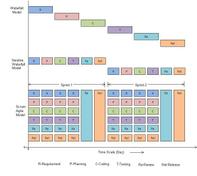Project Management Professional (PMP) Basics
Advertisement
This article covers the basics of managing projects professionally (PMP), which is very useful for practicing project managers as well as future project managers who aspire to clear the PMP exam. Theoretically, there are 5 process groups and 9 knowledge areas defined for project management in PMBOK (Project Management Body of Knowledge) released by PMI (Project Management Institute).
The 5 process groups are:
- Initiating process group
- Planning process group
- Executing process group
- Monitoring and control process group
- Close process group
The 9 knowledge areas are:
- Project integration management
- Project scope management
- Project time management
- Project cost management
- Project quality management
- Project human resource management
- Project communication management
- Project risk management
- Project procurement management
There are about 44 project management processes which are mapped between the five process groups and nine knowledge areas.

Let us understand the challenge of a project manager in any project with the help of the scope triangle mentioned below. As shown in the figure, a project manager’s real challenge is to control equally three main parameters during the execution of the project: time, cost, and quality based on the scope defined at the start of the project.
There are some maintenance/development projects where the scope keeps changing based on the need of the customer or varying customer requirements. In this situation, an agile way of managing projects is the ideal choice rather than a waterfall approach.
Other than the above, human resource management throughout the project is also important. The project manager needs to ensure that the same number of human resources are available from the initiation of the project till the end. The main three processes in HR management are: acquire team, develop the team, and manage the team.
PMP - Activity Duration Estimation
At the start of any project, the project manager lists various requirements and maps them to tasks, assigning human resources who are actually going to carry out the tasks during the execution of the project.
After mapping the tasks to human resources, the project manager will estimate the time duration for each of these activities (tasks) with the help of the team. There are various ways to estimate activity duration; the most popular among them is PERT. The estimate is based on P (Pessimistic time), M (Most likely time), and O (Optimistic Time).
The formula is:
Activity duration = (P + 4M + O) / 6
The project manager will usually include some buffer to avoid last-minute delivery problems to the customer.
The time versus activities chart created is called a Gantt chart and can be generated using Microsoft Project and other useful project management tools. In a Gantt chart, time is on the horizontal axis and various activities are on the vertical axis. Time can be in units of hours, days, months, or years. Human resources are also shown along the activities.
Time Compression Methods
The most adopted project management techniques for time compression are fast-tracking and crashing.
In fast-tracking, multiple activities are executed in parallel. For this, the Finish-start relationship between activities needs to change to start-start.
In the other technique called crashing, skilled resources are pulled from other projects and put into the delayed project to finish it fast and on time.
Project management techniques can be gained by applying them practically, and hence this article covers a few of the points of project management.
Advertisement
 RF
RF


